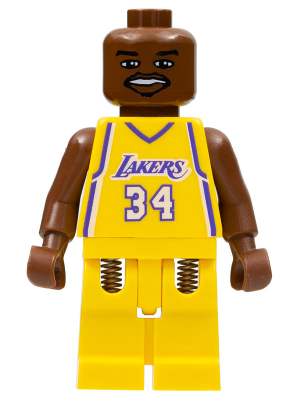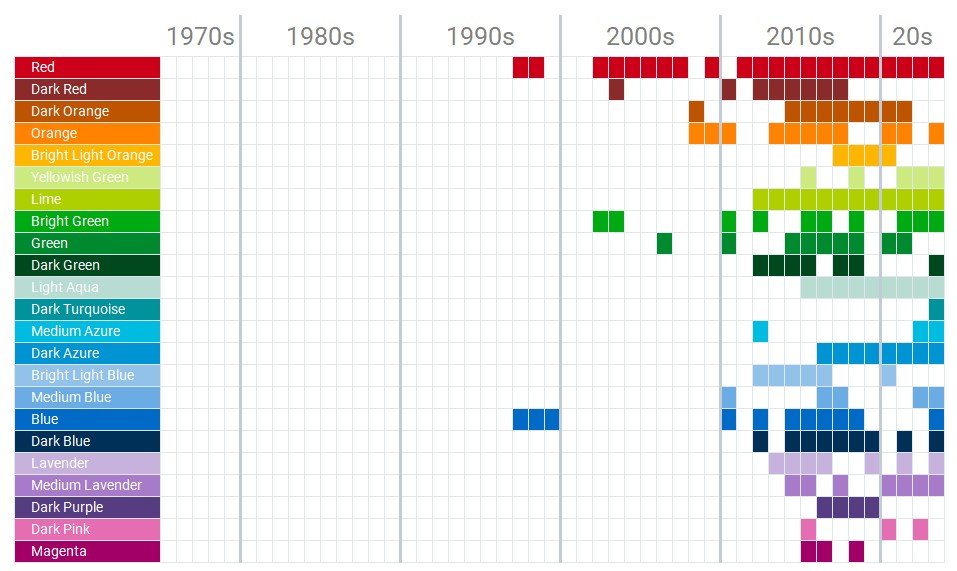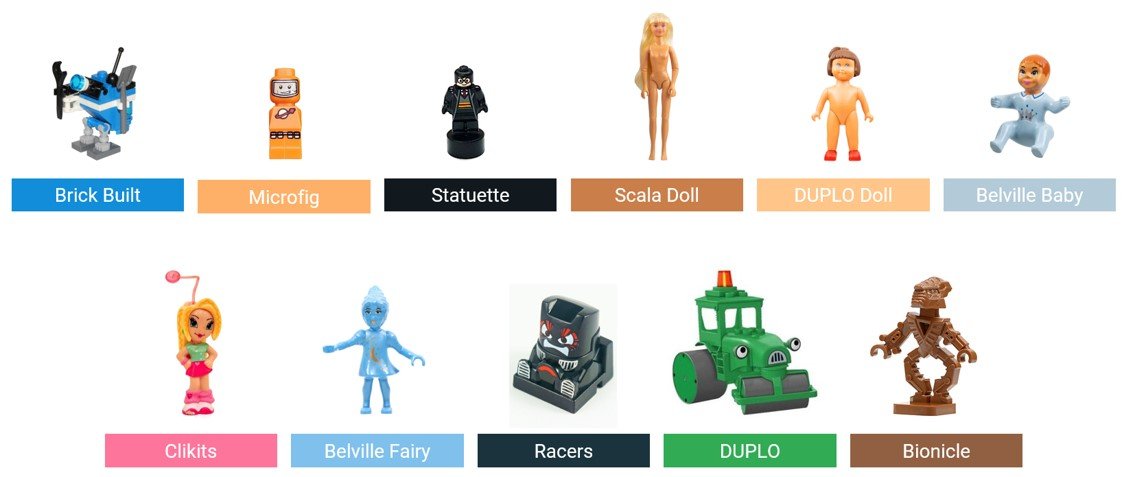LEGO Minifigure Skin Tones Over Time: The Changing Colors of an Icon
/The minifigure head element is a timeless mold that will be around for as long as The LEGO Group still exists. During its 48 years of service, its shape remains unchanged, but the variety of colours and prints makes it one of the most aesthetically interesting pieces in the LEGO canon. Today, we’re going to focus on its colours, in particular, the evolution from classic yellow to realistic human tones, and how this helped the minifigure head become LEGO’s most “charismatic” part.
Star Wars Minifigure Head Tones, 1999 to 2023 (Including non-printed heads). Data Source: Rebrickable
Quick Quiz
There are currently 44 solid LEGO colours in use (excluding transparent, pearl etc). But only 40 of them have been used as a printed minifigure head…which four have yet to be used? You can find out at the end of the article.
From Classic Town to Nation State
Data Source: Wikipedia… yes, I know.
At the turn of the millennia, 2,128 LEGO unique minifigures had been produced, and 97% of them featured the classic yellow head element. In 2023, that population has since increased to 15,918 (and probably passed 16,000 while you are reading this paragraph) with a huge variety of new colours, prints, and facial expressions.
The unique minifigure population is now actually bigger than three sovereign states – Nauru, Tuvalu, and Vatican City – and if it continues, it will pass Palau next year and be challenging San Marino by 2030.
The increase in LEGO themes, especially licensed themes, has driven much of this growth in numbers and as a consequence, the variety in their colourful craniums.
Licensed themes were introduced in 1999 and quickly moved on from the yellow head element to using realistic skin tones in 2003. Although unlicensed LEGO themes such as City, Castle, and Ninjago have remained yellow, it is sometimes easy to forget that Duplo and Friends have been using realistic skin tones since 1983 and 2012 respectively, albeit with different head elements.
Minifigure Population by Theme - Bubble Size reflects quantity
Data Source: Bricklink
The Minifigure Head Element
Before we look at colour changes, let’s take a look back at how the minifigure head element has changed over time. Part 3626a, the first version of the minifigure head, arrived with the release of the first minifigures or “static figs” in 1975. The more recognisable version of the minifigure arrived in 1978, adorned with a new and simple smiley face. (Read more on the design of the classic smiley face in this awesome BrickNerd article.)
There have been four different molds used for the standard minifigure head:
3626a - 1975 original minifigure head replaced in 1987.
3626b - 1987 second generation lasting until 2016.
3626c - 2008 current version.
28621 - 2013 current version mainly for transparent colours, although versions of solid colours have recently appeared on LEGO’s Pick a Brick service.
History of Minifigure Head Colours
This chart tracks the entire history of minifigure skin tones from 1975 to 2023. All four molds have been included, but it excludes all minifigure heads that are not printed except for the early static-figs and heads that are a completely different mold like an alien’s head, for example. It includes only solid colours, so no transparent, metallic, or pearl colours.
DATA Source: Rebrickable.
The results, although perhaps not entirely unexpected, are still quite satisfying to see in one chart. It shows two distinct phases that roughly pivot around the year 2000. The first phase, or epoch, to make it sound more epic (an epic epoch?), is before the start of licensed themes with 97% of heads being yellow. In the second epic epoch, yellow still continues as the most used colour, but realistic skin tones, and some very unrealistic skin tones take up around half the released head colours.
The Yellow Epoch - 1975 to 2000
The vast majority of figures before 2000 used yellow head pieces for all classic themes such as Castle, Space, and Pirates. LEGO has continued to use yellow for new in-house themes such including Ninjago, Monkie Kid, Modular Buildings, and Collectable Minifigures, meaning yellow still accounts for roughly 50% of head elements today.
But there were still some non-yellow exceptions prior to 2000, including OLD045, an all black version of the static-fig, used as a statue in 1980 as part of set 1592 Town Square Castle Scene, and the first to have a non-yellow head. But perhaps the most well-known early non-yellow colour was gen001 Skeleton with “Standard Skull” launched in the Castle set 6036 Skeleton Surprise and used in over 40 sets since.
The Realistic Epoch - 2000 to 2023
If we focus on the top right-hand corner of the previous chart, we can see the introduction of realistic skin tones beginning in 2003 and gradually increasing in share as we move through to 2023.
DATA Source: Rebrickable.
Brown and Nougat were the first realistic skin tones introduced in 2003 as part of the NBA license. Brown has since retired, as has Light Brown, which was used for the head element of just three minifigures between 2004 and 2006.
Perhaps the NBA experience helped LEGO fully commit to the already established Star Wars and Harry Potter licenses to change from yellow to realistic tones… or maybe it didn’t. But, irrespective, the changeover of Star Wars and Harry Potter in 2004 began the Light Nougat boom, which would go on to become the dominant realistic skin tone.
The first Reddish Brown heads were released in 2006, replacing Brown. Medium Nougat landed in 2016, but that only brought the number of skin tones in use to four (I’m excluding Dark Orange from this—more on that in a minute).
However in 2022, LEGO introduced Medium Brown and Medium Tan, expanding the palette and allowing for a wide range of distinct and more accurate figures.
Image of Dark Orange Ugha Warrior taken from Brickset (thanks, new images are tremendous), with the remainder sourced from LEGO and Bricklink
Dark Orange has been used twice for human minifigures, including the 2006 Ugha Warriors trying to prevent Indiana Jones from acquiring crystal skull, and Pharah from Overwatch, appearing in a 2019 set.
Dark Brown last appeared as a minifigure head in Legends of Chima in 2014 but has yet to be used as a human minifigure.
Skin Tone Inventory
By mid-2023 and after 48 years of minifigure production, Yellow and Light Nougat accounted for 97% of skin tones, with just 3% for the remaining seven skin tones, both retired and current.
Yellow and Realistic Skin Tones, 1975 to 2023
DATA Source: Rebrickable.
This number may initially seem low, but given the context of Yellow being essentially the only skin tone for 25 years, and LEGO being at the service of the source material for licensed sets, the numbers start to look a little more understandable.
DATA Source: Rebrickable. .
In addition, the recent trend shows Light Nougat reducing from 87% of realistic skin tones between 2000 and 2009 to 72% in 2023, with the remaining five colours now accounting for 28%.
Star Wars Minifigure Head Colours
We can see this trend of adding more colours of minifigure heads more specifically in the Star Wars theme. Between 2006 and 2020, Light Nougat accounted for 78% of colours, falling to 44% in the last three years.
Source: Rebrickable.
DATA Source: Rebrickable.
Unlike licensed themes where the source material must be adhered to, LEGO has complete freedom to create their own Friends characters. This freedom has delivered what might be the widest array of skin tones in a major LEGO theme.
Dulpo, like Friends, is another in-house LEGO theme that has been using realistic skin colours for some time. I wanted to do a similar analysis, but getting the data just for the head element is difficult as a Duplo figure is one whole multicoloured piece. So I did what all good pragmatists do—gave up and went to watch someone playing computer games on YouTube.
Bright Colours - Non-Human Skin Tones as Minifigure Heads
As well as the increase in realistic skin tones, there’s also been an increase in vibrant skin tones. Bright, highly saturated colours have grown in usage, accounting for 6.2% of minifigure heads in the last ten years, exactly double its share the decade before.
Bright Minifigure Head Colours, 1975 to 2023
DATA Source: Rebrickable.
Some of LEGO’s in-house themes including Nexo Knights, Legends of Chima, Ninjago, and Monkie Kid helped proliferate more of these distinctive shades, as did some of the big licensed themes.
One note of apology is to the transparent, pearl, metallic, and glow-in-the-dark heads, which although small, still contribute 3 in 100 minifigure heads. I chose to just concentrate on solid colours this time as the change in realistic skin tones is what we were really trying to understand.
There was just one figure with a Chrome Gold minifigure head element, but of course, I don’t need to tell you which minifigure that belongs to… do I?
Final Thoughts
I realize that minifigure skin tones can sometimes be an emotive subject, so I’ve tried to write the whole piece as straightforward as possible, presenting the numbers without any political, social, or ideological commentary. I hope that’s been appreciated and understood by anyone who might have expected it.
If you sat down and asked a LEGO enthusiast to draw the timeline of minifigure head colours, the final product wouldn’t be too dissimilar to our original smiley face chart… A big chunk of Yellow, followed by a healthy blob of Light Nougat, then an expanding mix of other skin tones, along with a random splash of colour to jazz it up a bit. This article doesn’t contain any new information but instead focuses on visualising it so we can better see trends over time.
That said, seeing the scale of the increase of realistic skin tones other than Light Nougat in recent years was interesting—and probably new information for most, myself included. In particular, seeing how those skin tones have been represented in the Friends theme was very interesting.
But the final credit has to go to the charts. It’s not often you pull together a chart that is not only the best way to present the information, it also looks pretty—and is a world away from the standard bar and line charts. There is one final chart I’d like to share, one which shows how often each solid colour has been used as a minifigure head piece. This could easily have been a bar chart, but I think I like it better this way.
Quiz Question Answer
So what four colours have never been used for a minifigure head yet (as of Nov. 2023)? I had a think, and given some colours are easier to guess than others (Neon Yellow is always the answer!), I’ve allocated a different number of points in a completely arbitrary manner, but there it is.
Credits and Methodology
All images from The LEGO Group or BrickLink, unless otherwise stated.
Data obtained from Rebrickable on 16 October 2023.
The BrickLink definition of a minifigure is used at the start of this article to refer to the total number of unique minifigures produced. This is an extremely broad definition that essentially includes every character (with human-level cognition) that has ever been produced by LEGO. This includes figures that do not at all resemble the classic minifigure including Scala dolls.
For a minifigure to be included in the data set, it must have appeared in a set. If the same minifigure appears in two sets, it was included twice. This logic was chosen to give a fairer representation to figures that appear in multiple sets, multiple times.
Minifigure heads must be printed to be included, meaning plain minifigure head pieces behind masks were excluded as were moulded heads.
Although the original 1975 “static-figs” had plain faces, they have been included as being representative of the minifigure at the time.
Minifigure head element is defined as parts 3062a, 3062b, 3062c, and 28621.
Minidoll head is defined as parts 28649, 14014, and 92198.
The population table assumes the most common definition of a country or state, which is the 193 UN Members plus two observer states.
Postscript - What is a Minifigure Anyway?
This should be a whole other article, but briefly, the BrickLink definition of a minifigure is used at the start of this article to refer to the total 16,000 unique minifigures. This is a broad definition, which includes every character produced by LEGO with human-level cognition. I say human-level cognition because some potential minifigures belong in the animal, or “beast,” category. For example, Jabba the Hutt is a “minifigure,” but the Rancor is not as it can’t figure out the square root of 16.
This means the BrickLink definition includes a number of “characters” that in no way represent a minifigure including the following:
Rebrickable has a much tighter, and I would say more accurate definition of a minifigure, and given we have only been analysing specific parts (the minifigure head and minidoll head), the Rebrickable definition has been used for this article.
Best of BrickNerd - Article originally published November 2, 2023.
What other data visualizations about LEGO would you like to see? Let us know in the comments below.
Do you want to help BrickNerd continue publishing articles like this one? Become a top patron like Marc & Liz Puleo, Paige Mueller, Rob Klingberg from Brickstuff, John & Joshua Hanlon from Beyond the Brick, Megan Lum, Andy Price, Lukas Kurth from StoneWars, Wayne Tyler, LeAnna Taylor, Monica Innis, Dan Church, Roxanne Baxter, and Steven Laughlin to show your support, get early access, exclusive swag and more.


























